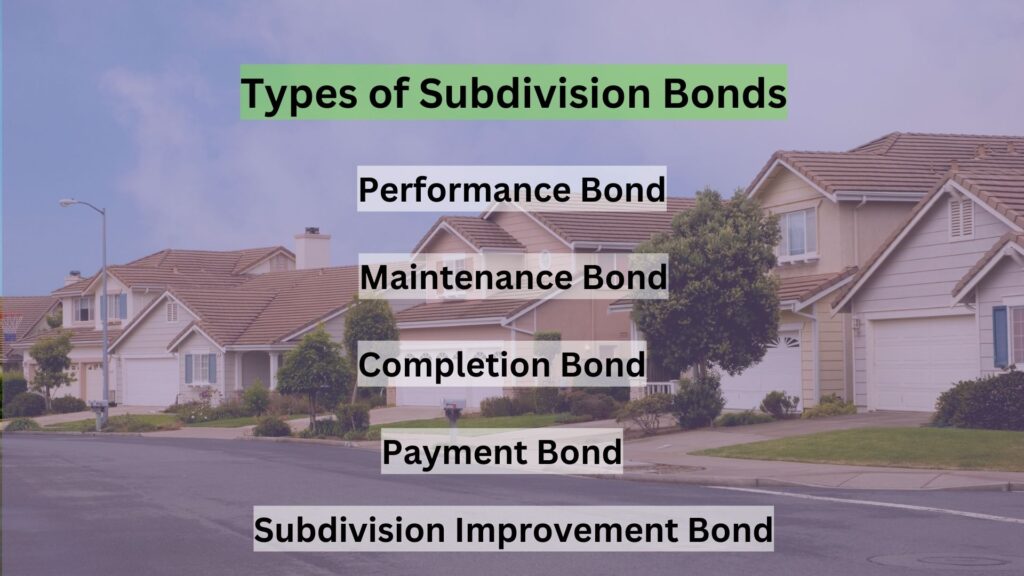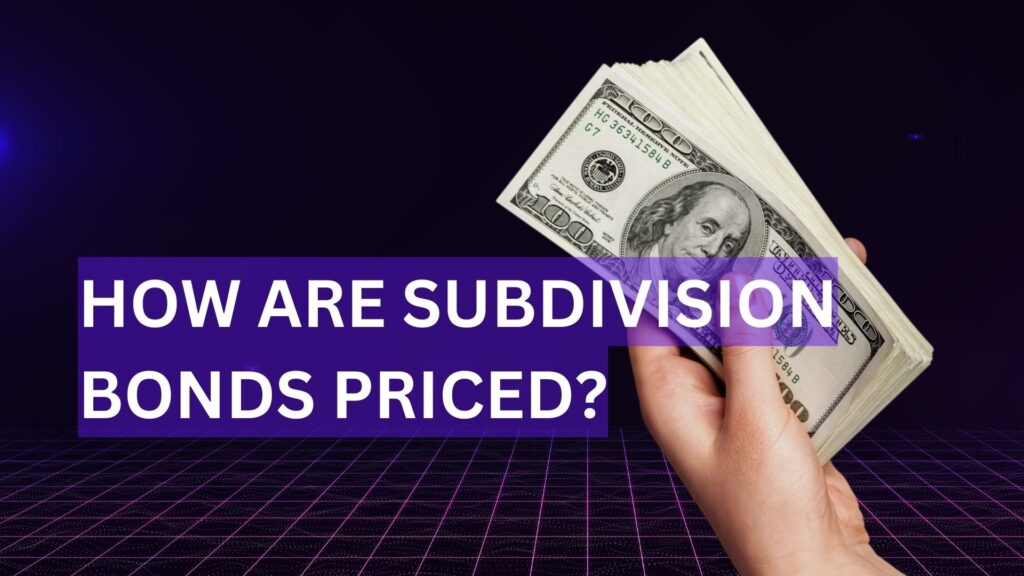Subdivision Bonds
What Are Subdivision Bonds?
How Do Subdivision Bonds Work?

Types of Subdivision Bonds
Performance Bond
This type of bond ensures that the developer completes all the required improvements and infrastructure according to the approved plans and within the specified timeframe. If the developer fails to meet these obligations, the bond’s issuer (usually a surety company) will step in and provide funds or resources to complete the project.
Payment Bond
A payment bond guarantees that the developer will pay all subcontractors, suppliers, and other parties involved in the development process. If the developer fails to make payments as required, the bond issuer will cover the outstanding amounts.
Maintenance Bond
Once the infrastructure improvements are completed, a maintenance bond may be required. This bond ensures that the developer maintains and repairs the infrastructure for a specified period (often 1-2 years) after completion. If any issues arise during this maintenance period, the bond issuer is responsible for ensuring the necessary repairs are made.
Subdivision Completion Bond
This type of bond is used when a developer wants to release a portion of the subdivision for sale before completing all the required improvements. The bond ensures that the outstanding infrastructure work will be completed as per the approved plans.
Subdivision Improvement Bond
In some cases, a local government may require a developer to post a subdivision improvement bond to ensure that the necessary infrastructure work is completed in the event that the developer defaults or becomes unable to fulfill their obligations.
Subdivision Agreement Bond
This type of bond is used to guarantee the performance of obligations outlined in the subdivision agreement between the developer and the local government or municipality.
It’s essential to note that the specific names and requirements of subdivision bonds may vary depending on the jurisdiction and local regulations. Developers should work closely with local authorities and surety companies to ensure they meet all necessary bond requirements for their particular project.
Benefits of Using Subdivision Bonds
Subdivision bonds offer several benefits to various stakeholders involved in real estate development projects. Some of the key advantages of subdivision bonds include:
Financial Security
Subdivision bonds provide financial security to local governments and municipalities by ensuring that the developer will fulfill their obligations to complete the required infrastructure improvements. In the event of a developer’s default, the bond issuer (usually a surety company) becomes responsible for covering the costs of completing the unfinished work.
Infrastructure Completion
The primary purpose of subdivision bonds is to guarantee that necessary infrastructure, such as roads, utilities, drainage systems, and public amenities, will be completed as per the approved plans. This helps in the timely and efficient completion of the development project, benefiting both the developer and the community.
Consumer Protection: For potential property buyers and residents of the new subdivision, subdivision bonds offer protection. With a bond in place, buyers can have confidence that the promised infrastructure will be completed, enhancing the overall value and livability of the community.
Risk Mitigation
Subdivision bonds help mitigate risks associated with real estate development projects. By requiring the developer to obtain a bond, the local government ensures that the project is more likely to be completed successfully, reducing the chances of abandoned or incomplete developments that can negatively impact the community.
Developer’s Credibility
Posting a subdivision bond can enhance the developer’s credibility in the market. It signals to potential buyers, investors, and financial institutions that the developer is committed to completing the project according to the approved plans and that there is a safety net in place if anything goes awry.
Compliance with Regulations
Many local governments and municipalities mandate subdivision bonds as a part of their development approval process. By obtaining and maintaining a bond, developers comply with these requirements and avoid potential legal and financial penalties.
Better Community Planning
Subdivision bonds contribute to more organized and well-planned communities. The assurance of proper infrastructure encourages responsible development practices that take into account the needs of the residents and the environment.
Increased Property Values
Completed infrastructure and well-maintained amenities can lead to higher property values within the subdivision. This benefits both the property owners and the local government in terms of increased tax revenue.
Overall, subdivision bonds play a crucial role in ensuring the successful development of real estate projects, protecting the interests of stakeholders, and promoting sustainable and well-planned communities.
What Are the Risks of Subdivision Bonds?
What Is the Purpose of a Subdivision Bond?
What Are the Requirements for a Subdivision Bond?

Who Are the Underwriters of the Subdivision Bonds?
